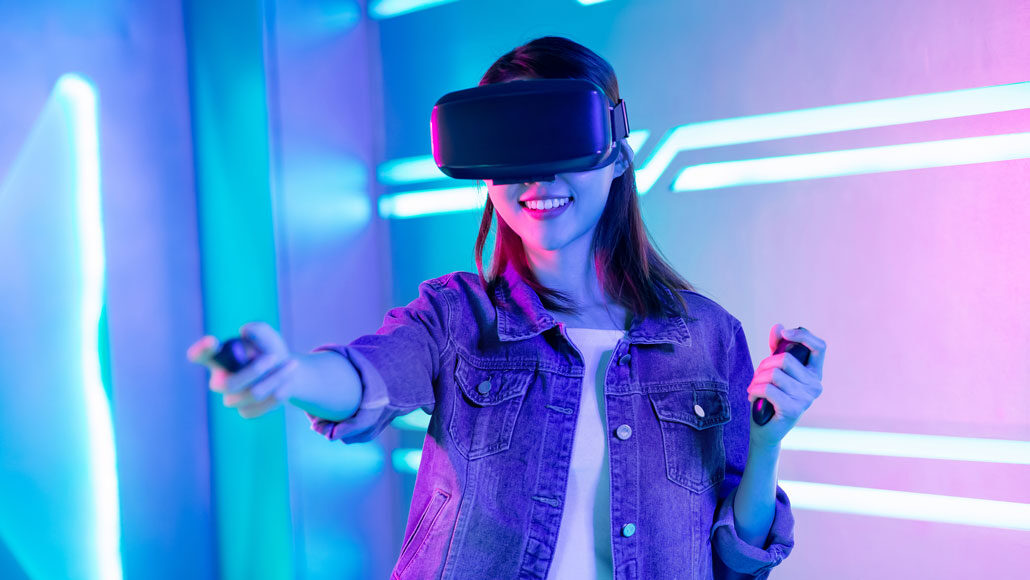Let’s learn about virtual reality!

Technology can fool our eyes into seeing different worlds!
December 1, 2020 at 6:30 am
Most of us haven’t been able to travel a lot lately. But with virtual reality, you can visit the beach, explore a mountain or more — all without leaving your house. Virtual reality (sometimes called VR) is technology that fools the brain into seeing an artificial world with depth, even though it’s based on flat pictures.
See all the entries from our Let’s Learn About series
Because our eyes are slightly separate from each other, each eye sees a slightly different image. In real life, that gives our eyes depth perception, and helps us see how far away things are. But in virtual reality, technology can present each eye with a slightly different image. This produces an illusion of a three-dimensional space. If computers send a constant stream of these images, you can turn your head, walk and dance around full virtual worlds.
Many people enjoy games in virtual reality. But there’s science to be done in virtual worlds, too. Some scientists are using virtual reality to help people conquer their fear of heights. Others are using it to help people feel less pain.
Right now, virtual reality is mostly visual. People can’t hear sound or touch objects in these virtual worlds. But scientists are working on that, too. One day, you might be able to wander one of these worlds and touch or smell objects that aren’t really there at all.https://www.youtube.com/embed/-Kovxf6g0mo?feature=oembedThis video from MIT shows how a cardboard box and your phone can create a virtual experience.
Want to know more? We’ve got some stories to get you started:
Cool Jobs: Doing real science in virtual worlds: Virtual reality isn’t just for gamers. Scientists are using VR technology to tackle real-world problems. (4/13/2017) Readability: 7.1
Are you scared of heights? Virtual reality could help: In a therapy app, an avatar coaches people through sky-high situations. (8/14/2018) Readability: 8.2
Viewing virtual reality of icy landscapes may relieve pain: Traveling to polar vistas via virtual reality eased a temporary burning in the viewers’ skin. The same VR also lessened simulated chronic pain. (1/10/2020) Readability: 6.7
Explore more
Explainer: What is an algorithm?
Computers are changing how art is made
Cool Jobs: Video game creators
You don’t see as much color as you think
Feeling objects that aren’t there
If you want to explore the worlds available in virtual reality, you could purchase an expensive virtual reality headset. But you don’t have to. In fact, you can build your own with a little cardboard, some lenses and your smartphone.
Power Words
algorithm: A group of rules or procedures for solving a problem in a series of steps. Algorithms are used in mathematics and in computer programs for figuring out solutions.
app: Short for application, or a computer program designed for a specific task.
avatar: (in virtual reality) An electronic rendering of some image. It becomes the virtual form of some character (even a computer or game user) that will be moved and manipulated by a computer user. It can interact with its environment and other characters.
chronic: A condition, such as an illness (or its symptoms, including pain), that lasts for a long time.
data: Facts and/or statistics collected together for analysis but not necessarily organized in a way that gives them meaning. For digital information (the type stored by computers), those data typically are numbers stored in a binary code, portrayed as strings of zeros and ones.
illusion: A thing that is or is likely to be wrongly perceived or interpreted by the senses.
lens: (in optics) A curved piece of transparent material (such as glass) that bends incoming light in such a way as to focus it at a particular point in space. Or something, such as gravity, that can mimic some of the light bending attributes of a physical lens.
perception: The state of being aware of something — or the process of becoming aware of something — through use of the senses.
smartphone: A cell (or mobile) phone that can perform a host of functions, including search for information on the internet.
technology: The application of scientific knowledge for practical purposes, especially in industry — or the devices, processes and systems that result from those efforts.
therapy: (adj. therapeutic) Treatment intended to relieve or heal a disorder.
virtual: Being almost like something. An object or concept that is virtually real would be almost true or real — but not quite. The term often is used to refer to something that has been modeled — by or accomplished by — a computer using numbers, not by using real-world parts. So a virtual motor would be one that could be seen on a computer screen and tested by computer programming (but it wouldn’t be a three-dimensional device made from metal). (in computing) Things that are performed in or through digital processing and/or the internet. For instance, a virtual conference may be where people attended by watching it over the internet.
virtual reality: A three-dimensional simulation of the real world that seems very realistic and allows people to interact with it. To do so, people usually wear a special helmet or glasses with sensors.
Leave a comment